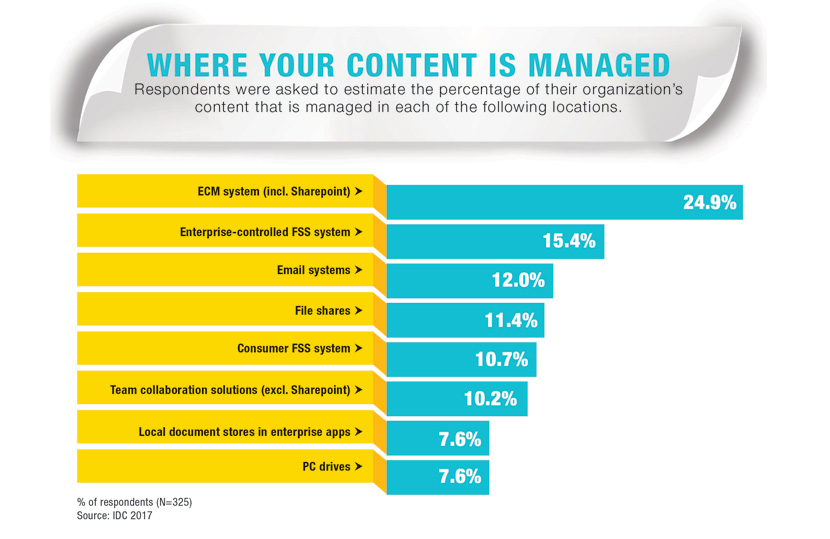This article appears in the Fall 2017 digital issue of DOCUMENT Strategy. Subscribe.

Image by: scyther5, ©2017 Getty Images
So, the boundaries between these technologies are evolving, expanding, morphing, merging, modularizing, and blending, but the requirement for organizations to manage content is as compelling as ever. For these reasons, we conducted a study earlier in the year to assess user needs and challenges related to managing enterprise content. We surveyed 375 technology influencers and/or decision makers in US organizations that had deployed or were evaluating ECM or FSS software.
It is no big surprise that reducing cost, improving operational efficiency, and increasing employee productivity continue to be the primary drivers for transforming content-intensive workflows and managing enterprise content. One-third of respondents also cite improving collaboration, both internally and with partners, as a key driver. While ECM is more often deployed to manage final-form content and as part of a content workflow automation or case management solution, FSS is considered more for supporting enterprise collaboration.

On average, only 40% of an organization’s content is managed by an enterprise-sanctioned ECM or FSS solution. Organizations (across all company sizes) typically have four different ECM systems by various vendors implemented at their company. Interestingly, over 65% of respondents expect to increase their budget for ECM over the next two years, and 47% expect an increased budget for FSS. At least part of this will be driven by consolidation—over 40% of respondents indicate that their organization will consolidate ECM vendors in the next 12 to 18 months, and almost one-third will consolidate their FSS providers. Only one-third of respondents expect no change, indicating a very dynamic market ahead.
When asked for the motivations behind changing, reducing, and/or consolidating their ECM or FSS suppliers, respondents cite obtaining additional capabilities and reducing the number of suppliers to deal with as the top reasons. In regard to ECM, almost 40% of respondents indicate the need to move content to the cloud, while one-third of respondents indicate the need to switch from FSS to an ECM solution.
Clearly, one solution (or solution category) is not meeting all needs. However, we believe that the days of deploying a monolithic, one-size-fits-all solution are rapidly fading. Instead, we expect to see larger numbers of purpose-built content management solutions, using the most suitable modules drawn from a common technology stack, with the goal of improving stakeholder and customer experience. As a result, traditional technology boundaries will diminish. Management tasks will be increasingly offloaded to cognitive solutions, including artificial intelligence (AI). In fact, in this research, over 60% of respondents indicate that they are currently using or planning to implement cognitive and AI technologies to manage unstructured content in their organization.
Yes, the requirement for organizations to manage enterprise content is as compelling as ever, but the metamorphosis of the technologies to support that effort continues.
Holly Muscolino is the Research Vice President of the Content Technologies and Document Workflow group at IDC and is responsible for research related to enterprise content management, including records management and case management. Follow Holly on Twitter @hmuscolino.










